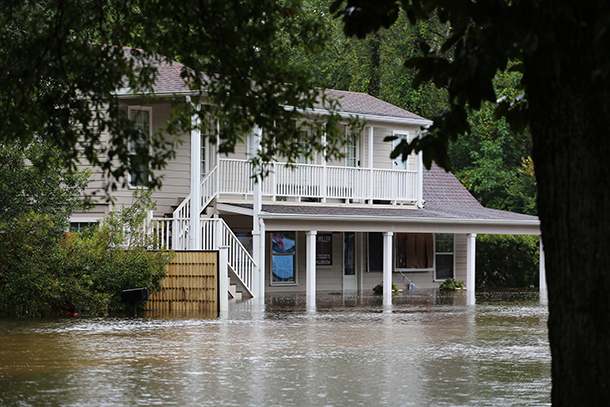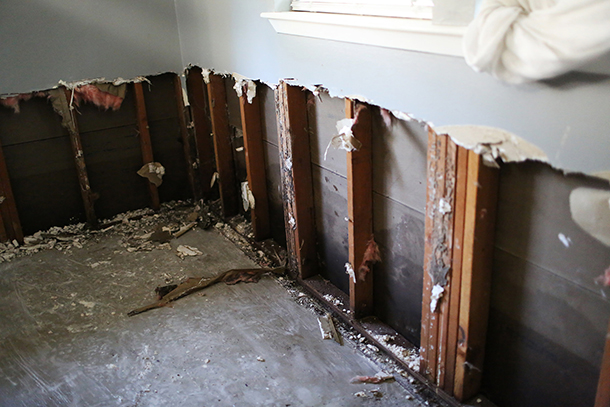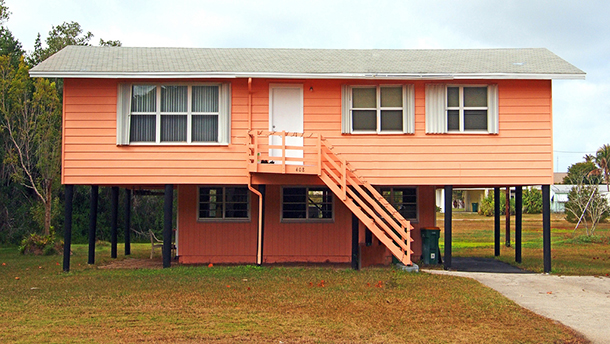Flood Insurance & Resilience
Air Date: Week of September 8, 2017

The floodwaters left by the 2017 hurricanes inundated many homes, most of which lack flood insurance. (Photo: Jill Carlson, Flickr CC BY 2.0)
As Hurricane Irma hits the US and Texas cleans up from Hurricane Harvey’s flooding, Congress faces a September 30th deadline to reauthorize the National Flood Insurance Program. Despite some problems with this program, Larry Larson of the Association of State Floodplain Managers tells host Steve Curwood that flood insurance shifts at least some of the costs of disaster recovery to homeowners to incentivize flood-resilient rebuilding. Larson argues Congress could improve incentives for prudent rebuilding for states and local communities as well.
Transcript
CURWOOD: It’s Living on Earth, I’m Steve Curwood.
Few people actually buy federal flood insurance. While premiums have been rising, they don’t cover claims, and the program runs out of cash on September 30th, unless Congress acts. Flood insurance needs a “rethink” to put it on a sound financial footing, and the US needs new policies to help mitigate future disasters.
Well, in a recent Washington Post op-ed, two flood risk experts, Larry Larson and David Conrad of the Association of State Floodplain Managers, describe how the Great Flood of 1993 in the upper Midwest briefly focused federal attention on the importance of mitigating flood risks. But that sense of urgency quickly waned, and at-risk communities, including Houston, Texas, largely ignored the need to mitigate flood risks.
And here now to discuss the issue is Larry Larson. He's Policy Director and Director Emeritus of the Association of State Floodplain Managers. Larry, welcome to Living on Earth.
LARSON: Thank you very much, Steve. It's good to be with you.
CURWOOD: Now, so, Larry, you clearly hoped the nation would learn its lesson after the 1993 floods. How close did we come to getting flood policy right at that point, in your view?
LARSON: Well, I think in terms of national policy we did something after 1993 that we had not been doing prior to that. Prior to that both in disaster relief and our flood programs, we were telling people we will help you rebuild after disaster, but we will only make you whole, we'll only build you the way you were, we will not help you mitigate.
We started to do mitigation after 1993. About 10,000 structures were bought and they were moved out of the flood plain in the one 1993 flood. That was the first time we did that. So, now after a flood, the disaster program will not only help you rebuild, there's a portion of the disaster program called the hazard mitigation match program that communities can put together an application and send it to FEMA and the state saying, “Here's a neighborhood of 50 homes that were flooded. The ones that are really low, here's an application. We'd like to relocate those people out. The other ones, we’d like to elevate three feet so they're above the flood level, and people can afford insurance.” And it's cost effective. It returns $4 for every dollar we spend. In the case of flood, it's $5 for every dollar.

Dealing with flood damage is expensive: every foot of water in a home costs about $20,000 worth of damage, and many homes in 2017 have been flooded with several feet of water. (Photo: Jill Carlson, Flickr CC BY 2.0)
And we do the same in the Flood Insurance Program. Policyholders actually fund a mitigation program called the flood mitigation assistance program at $175 million a year. FEMA uses that money and tries to focus that money on buying out those severe, repetitive loss structures. So the ones that are really draining the program. You've heard those stories. About 25 to 30 percent of the claims are from those two percent of the policyholders. So, that's one that they try to focus on.
CURWOOD: So, what is the present tab now that the federal government is picking up, in terms of disaster relief?
LARSON: Well, about 30 years ago the federal government paid about 24 cents on the dollar for disaster relief. Now it's about 76 cents. So, what we're seeing is that the federal taxpayer’s picking more of these costs. Well, if you look at where floods are happening, the big floods are happening in states that may do the least, in terms of preventing flood damage. And then, of course, Congress says, “Well, this was a major disaster because nothing was resilient, so now instead of giving you 75-25”, which is a standard cost share for disaster relief, 75 Fed, 25 percent un-Fed, we'll give you 100 percent.” So, we're kind of encouraging bad behavior with some of those policies. We've got to quit incentivizing poor behavior and instead let's incentivize good behavior.
CURWOOD: What about allowing people to build in these areas that have been known to flood and get insurance now? Why can people do this now?
LARSON: Well, we still sell car insurance to those people who have accidents. Now, they may pay more for their car insurance, but the same is true in flood. Now, we know after a disaster everybody will get disaster relief. The point of the flood insurance program was to say, at least those people at risk are paying a portion of that cost through their premiums. So, it makes sense for those in the floodplain to actually buy the insurance. We don't want to say, “Don't buy the insurance,” because then we're only going to have disaster relief, taxpayer dollars, to help after a flood. So, we need to better marry the flood protection standards in the NFIP with the disaster program to say, “Wait a minute, if you do a better job of making sure new development is at less risk of flooding, you'll be getting a better portion of disaster relief.” So, we've got to build in some kind of incentives. We were supposed to do that in the last administration. That is still being considered by this one, called “The Disaster Deductible”, saying to the states, “Every state will have a deductible which you must pay before we come in with the federal taxpayer dollars after a disaster, but the more you're doing to reduce floods on new development and redevelopment, the more credit we'll give you so that your deductible goes way down, and you already may be doing enough that you have no deductible.”
CURWOOD: By the way, why is it important for the nation to really get its flood risk mapping up-to-date, and how comprehensive is the mapping of flood zones today?
LARSON: Maps are the basis for what communities do in guiding development. They need that map.
There are in the United States about 3.5 million miles of coastlines and rivers that have flood plains. The NFIP has mapped about 1.2 million of those miles, so that's about a third, so that means we have two-thirds of the flood plains in the United States that have not yet even been mapped. Now, a lot of those are out in smaller communities, in rural areas because FEMA has focused on doing highly urbanized areas where they have the highest policy count, but they want to have as good a map as they can to get their premium rates determined. But the problem is, now that we keep redoing those maps instead of going out into the, what I call, “cornfields and cow pastures.” those other areas we need to map now and get ahead of development because that's where developments are going in, outside those areas and the suburban areas.

Raising homes above the level of predicted 100-year flood can greatly reduce damage and costs from floods. (Photo: JohnPickenPhoto, Flickr CC BY 2.0)
A developer comes out and says, “I'm going to put 200 homes out here...do I need a floodplain permit?” And the community says, “I guess not, we don't have a flood map showing we have a floodplain out there, so go ahead and develop.”
They do that, and then later FEMA comes along and says, “Well, we need to map that because there's a development out there now.”
They'll map it, and now all the people that have built probably built two or three feet too low, and now they're going to have to buy flood insurance, and the premiums are going to be up because they didn't build high enough. That's where the screaming starts and the people start shouting and saying, “Wait a minute!”
And that could have been avoided if we would map ahead of development. It cost only one or two percent higher to elevate a structure two feet on the development costs, so if we can get ahead of development we can start to prevent some of these problems.
CURWOOD: A number of folks said that, in Houston, development was permitted in areas that made no sense in terms of flood plain, but how much did all that development affect the flooding in Houston?
LARSON: A tremendous amount. You can't pave over thousands of acres of what was wetland or a lot of it was pasture area and so on and not have an impact on runoff because you took all that pervious surface that would soak up water and turned it into an impervious service where the water simply runs off.
CURWOOD: How well can you guess what happened in Houston in terms of an increased flood level due to this, all this impervious surface that was there? How many feet do you think it might have cost people in areas of Houston to have paved over so much?
LARSON: I can't really say. I mean, you can do a study on that. Charlotte, Mecklenburg found out that if their small watersheds were fully developed, the flood levels would go up anywhere from two to nine feet. They mapped future conditions, so that when people built, it would be safe when full development occurred. So, that shows you what kind of impact development has on a watershed.

Much recent construction in the Houston area was built on what used to be marshland and grassland, replacing these water-absorbing ecosystems with mostly impervious surfaces. (Photo: Nelson Minar, Flickr CC BY-SA 2.0)
We're doing a little better job of doing our studies on a watershed basis, but, as you know, community boundaries don't match watersheds. So, given this, community A can work with community B to consider the runoff and the impact of that development it's going to have. That's one of the reasons we develop what we call “a no-adverse impact approach” and try to help communities look at this to say, “Don't just look at what's happening in your floodplain. Look at what's happening in your watershed, and if all that stuff is increasing your flood flows you’d better account for that.” That's a no-adverse impact approach.
CURWOOD: What's under consideration now in the Congress, in terms of reforming the flood insurance policy, and, I gather, making an appropriate link to disaster relief with it?
LARSON: Well, the House bill has a heavy focus on allowing the private sector to sell flood insurance directly which is kind of surprising because they opened it up in 2012, in the reform of 2012, and frankly the private market is coming aggressively into the program now. It's selling private flood insurance throughout the nation now. They have a small amount. The numbers I've read are around 200,000 policies compared to the NFIP at 5 million
And our biggest concern with private flood is the way the bill was written. The private flood policies would not be required to pay a $50 a year policy fee that all in NFIP policy holders pay. That money pays for about half of the costs of new mapping, and it pays for all the floodplain management, providing assistance to those 22,000 communities that belong to the program because they need to know what their role is. They need to be monitored. They need to understand their maps, know how to do the job. So, we're very concerned about that.
In the Senate what you're seeing is more efforts to address the mapping, and say “Let's get the mapping done,” authorizing more money for mapping. That's not appropriations, you understand, that's authorization. But they also have a lot of stuff on mitigation and that has to happen. There's a small piece of the flood insurance policy that's very important to mitigation. It's a rider on every policy that says, “You have a rider that provides money for increased costs of compliance. “
Let me explain. It's kind of like how your homeowners insurance might have an law and ordinance provision that says, “If your community because you were damaged so heavily” and typically that number is 50 percent of the value, “then when you rebuild you must rebuild to today's code.” In the case of flooding, for example, in Sandy, that means, well, today's code may mean you can rebuild at that spot, but you’ve got to elevate your home five feet. Well, that increased cost compliance provision would provide you up to $30,000 to help you elevate. We like that.
The problem is that it we found out between Katrina and Sandy that it costs somewhere between $50,000 and $120,000 to elevate a building. So, for the person that had $50,000 in the bank, that's $30,000 really helps. For the person that's living paycheck to paycheck it says, “Well, it's going to cost you $80,000, and here's $30,000 by the way.” That's just another $50,000 loan they've got to add on top of the loan they're already struggling to meet. So, the Senate diversions are saying, “Let's increase that to $60,000 or to $100,000 so that people can actually mitigate after the flood.” Again, going back to the fact that if we help them mitigate we're getting a four-to-one payback for the taxpayers, so, let's get that done. So, that's a very important piece and if that provision can be increased, and the Senate bills do that, they increase that significantly, we think that that's a move in the right direction.
CURWOOD: Larry, let's step back for a moment. I want you to give me the big picture for the small person. So, if I have a dwelling unit there in Houston, and I had bought flood insurance, what kind of financial ride am I in for now for this, say, $175,000 home that I have?
LARSON: Well, let's assume that, of course, you're only required by the law to buy enough insurance to cover the mortgage. So, on that $175,000 home you just talked about, if I had a mortgage for $100,000, that's all I had to buy. If I had a mortgage for $20,000, I only want to buy $20,000 dollars worth of flood insurance, and unfortunately the propensity of the average person is to buy the minimum amount. So, if I had a $20,000 mortage, I bought $20,000 worth of flood insurance, and that's all the bank cares because they know they're going to get their money.

Larry Larson is a policy advisor and director emeritus of the Association of State Floodplain Managers. (Photo: Association of State Floodplain Managers)
This program, in fact, the courts in some court cases, the courts have said, “Well this program was really designed to protect the banks, not the policy holders.” So, let's say that person had just had $20,000 and now I have four feet of water in my house. Well, one feet of water typically costs $20,000. Two feet of water costs $40,000. If you had four or five feet of water, you're probably looking at at least 50 percent of the value of that structure. You probably had $80,000 of damage, and, if you were fortunate that your mortgage was high enough so that you actually had $100,000 worth of coverage, then you'll get a pretty good return and if you didn't have flood insurance, now you're going to be at the whim of disaster relief.
And the disaster program has two major elements. One is called public assistance, which builds roads and highways and sewer plants and water plants and all those public facilities. And the individual assistance which will provide some minimal assistance to individuals. It's usually temporary housing. That's authorized to pay up to $32,000 for a family. The average is about $7,000.
CURWOOD: Sounds to me that a lot of folks who got flooded out in this spate of storms are literally underwater financially and may be tempted simply to walk away from these homes.
LARSON: Well, we saw some of that happen, and we've seen that happen in the past, and I think you're going to see more of that happen in the future because, as we see these high damage amounts and people not having insurance, it's a problem. Until we get to the point where insurance is ubiquitous, and it's probably going to have to be mandatory, our experience is that the only people that buy flood insurance are where it is mandatory to buy it. It's difficult for people to judge risk because people, first of all, don't think their area is going to flood. and if it does flood, they surely don't think it's going to happen to them. That's just the mindset of people, period. And that's, that's a mindset that's very difficult to overcome, and that's one of the problems we face in trying to run our program.
CURWOOD: Larry, we're seeing rising sea levels with, with climate disruption. How does that affect the whole flood insurance program?
LARSON: What we're going to see along the coast, as sea level rises, is the insurance companies and the bond rating companies are going to look at the value of that real estate, and frankly when sea levels go up a foot or two, a lot of that real estate is going to lose value. That's very high priced real estate, and suddenly those $300,000, $400,000 homes are going to go down $100,000 in value. Well, that affects the community's bond rating because that reduces their taxes, doesn't it?
So, as we see a sea level rise, we're going to see this resilient factor playing well into the financial stability of the community. These are going to be tough issues that communities are going to have to address, and some are. The Miamis and some of the Florida communities, and New York City is taking a very careful look at this and saying, “We've got to prepare for the sea level rise. It is happening. It is happening now. We've got to make sure that we're resilient as community and that we stay financially strong.”
CURWOOD: As we face all of these storm disasters this year -- Harvey, Irma, and who knows what else -- how much comfort should we feel with the existing flood insurance program? If you were to give it a grade, is it an A, a B, a C, a D? An F?
LARSON: I would say it's about a C. I think it's a program that's very important, and frankly 50 years from now I would hope that flood insurance is actually sold by the private sector. It’s part of your homeowner's policy. Think about it. That makes good sense. You would buy one policy for your home and it covers everything, including all floods, earthquakes, fires, what have you. But we need to transition to that in a smart way so that we don't lose the other key elements of that comprehensive flood risk management program - mapping, mitigation, regulation. That's kind of what needs to happen if we want to get there.
CURWOOD: Larry Larson is a Policy Advisor and Director Emeritus of the Association of State Floodplain Managers. Larry, thanks so much for taking the time today.
LARSON: Thank you very much.
Links
Washington Post: “We already knew how to reduce damage from floods. We just didn’t do it.”
Living on Earth wants to hear from you!
Living on Earth
62 Calef Highway, Suite 212
Lee, NH 03861
Telephone: 617-287-4121
E-mail: comments@loe.org
Newsletter [Click here]
Donate to Living on Earth!
Living on Earth is an independent media program and relies entirely on contributions from listeners and institutions supporting public service. Please donate now to preserve an independent environmental voice.
NewsletterLiving on Earth offers a weekly delivery of the show's rundown to your mailbox. Sign up for our newsletter today!
 Sailors For The Sea: Be the change you want to sea.
Sailors For The Sea: Be the change you want to sea.
 The Grantham Foundation for the Protection of the Environment: Committed to protecting and improving the health of the global environment.
The Grantham Foundation for the Protection of the Environment: Committed to protecting and improving the health of the global environment.
 Contribute to Living on Earth and receive, as our gift to you, an archival print of one of Mark Seth Lender's extraordinary wildlife photographs. Follow the link to see Mark's current collection of photographs.
Contribute to Living on Earth and receive, as our gift to you, an archival print of one of Mark Seth Lender's extraordinary wildlife photographs. Follow the link to see Mark's current collection of photographs.
 Buy a signed copy of Mark Seth Lender's book Smeagull the Seagull & support Living on Earth
Buy a signed copy of Mark Seth Lender's book Smeagull the Seagull & support Living on Earth

